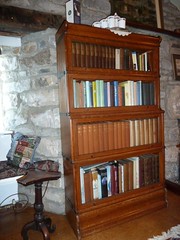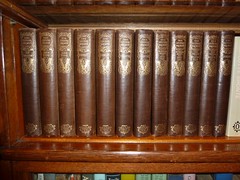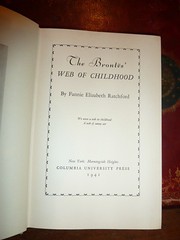
Bronte aficionados may recognise the distinctive orange of the Shakespeare Head Bronte or the brown and gilt of the handsome Dent edition. I started my previous account with 'Jane Eyre', so that makes it a good place to start a discussion of the compulsion to build up a set of books relating to one author (or, as in this case, a group of related authors - forgive the double meaning).

Everything about 'Jane Eyre' makes for a gripping story; from the all-night read of the manuscript by W S Williams at Smith, Elder to the sisters' visit to London to confirm their identities to George Smith, the publisher. So a collection must begin there. But then you have the other novels (and, of course the poems); so far not too out of control, but then you discover that there is a whole other layer - the juvenilia - epics of Gondal and Angria, short fragments and whole stories with which the sisters wove their web in childhood while the winter winds raged on the surrounding moors. This brings me to one of the best books on this aspect of their lives, Illustrated here.

'We wove a web in childhood
A web of sunny air ...'
By now, we are well and truly entangled and the Angria/Gondal collection grows. Then comes a decision about what represents your definitive collected edition of the works - not so simple, given the many excellent choices, for example, the Haworth Edition, the Thornton Edition, and Smith, Elder's own editions of the works. But, homework done, you realise that the Shakespeare Head Edition, edited by Thomas J Wise (of whom much more in later blogs) is the one. Then, by serendipity, a set appears on a stall on Chester Market.
Next biography and bibliography. You have to have the latter to check your collection for any obvious gaps. Again, you are well served by Thomas J Wise and, more recently, Yablon and Turner, not forgetting, for those, who unlike me have infinite resources, the Heritage Press Bibliography of First Editions.
Biography begins with Mrs Gaskell (and could end there were it not for Winifed Gerin, Juliet Barker and others).
Then to your horror you discover the Letters. Why did Charlotte write so many and why are they published in such expensive editions? But, without them is your collection truly representative? Then there are books continuing, or seeking to illuminate, the novels or the sisters' lives in novel form. Only one need detain us, illustrated below:

Enough. This sketch of how a collection might be formed, I hope, explains why the bookcase that housed my father's entire collection now houses works by, or about, one author and her siblings. There is one exception to this - tucked away on the bottom shelf is a set of the works of Bewick, the author whose engravings the young Jane Eyre was studying in the window-seat at Gateshead on that day when there was no possibility of taking a walk. I would like to think that the bookcase from which she selected Bewick's 'A History of British Birds' for her solitary occupation was not dissimilar, in the author's mind, from the bookcase now housing the modest collection described above.

No comments:
Post a Comment
Please feel free to comment.